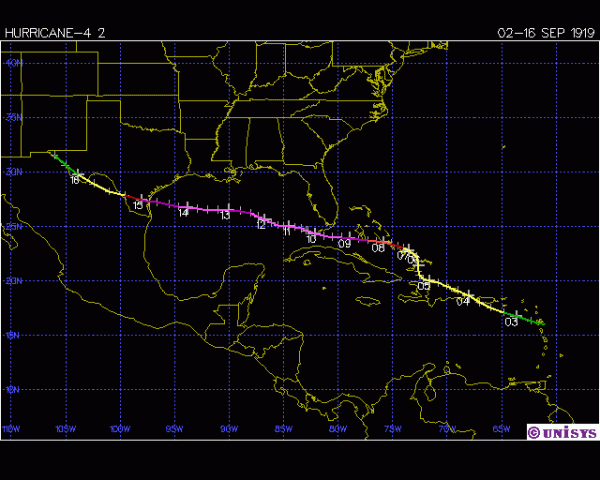Track of 1919 Great Florida Keys Hurricane
On September 10, 1919 a major hurricane roared through the Florida Keys, causing considerable damage on land and havoc at sea. Prior to its Keys landfall, the storm had brought substantial damage to the central Bahamas with many buildings destroyed and people left homeless. After the Keys, the hurricane moved westward making another devastating landfall at Corpus Christi, Texas. Roughly 65% of the 772 deaths attributed to the hurricane resulted from ships sinking at sea. This makes the storm the sixth deadliest in the United States. It is also rated the sixth most intense hurricane at landfall by central pressure.
The storm was first detected as an area of disturbed weather moving through the Lesser Antilles. It strengthened into a tropical storm as it brushed Puerto Rico and moved through the Mona Passage. It became a hurricane while over the eastern Bahamas and rapidly intensified as it moved westward. It reached its peak intensity with 150 mph (240 km/hr) winds as it moved over the Florida Keys during the night of Sept. 9-10th. It spun up a major waterspout over Biscayne Bay which came ashore at Goulds, FL and caused US$25,000 in damage. The hurricane tracked slowly west-northwestward over the Gulf of America over the next four days as its strength went through several cycles of weakening then strengthening. It was during a weakening phase that it made landfall at Corpus Christi on the afternoon of Sept. 14th with sustained winds estimated at 115 mph (185 km/hr).
Bob Simpson in 2013
The city was caught largely unaware and many people had to scramble to safety from the storm surge. Among them was the Clyde Simpson family, who made their way to the courthouse on a bluff overlooking the lower areas of town. Clyde’s six-year old son Robert watched people struggle against the storm through the building’s windows, making a lasting impression. Bob Simpson would go on to become the first director of the National Hurricane Research Project and then second director of the National Hurricane Center.
Related publications:
- Landsea, C. W., D. A. Glenn, W. Bredemeyer, M. Chenoweth, R. Ellis, J. Gamache, L. Hufstetler, C. Mock, R. Perez, R. Prieto, J. Sánchez-Sesma, D. Thomas, and L. Woolcock, 2008: A Reanalysis of the 1911–20 Atlantic Hurricane Database. J. Climate, 21, 2138–2168.
- Pielke, R. A. Jr. and C. W. Landsea, 1998: Normalized Hurricane Damages in the United States: 1925–95. Wea. Forecasting, 13, 621–631.
- Simpson, R. H. “Hurricane Pioneer: Memiors of Bob Simpson”, 2014, University of Chicago Press, 272 pp.

